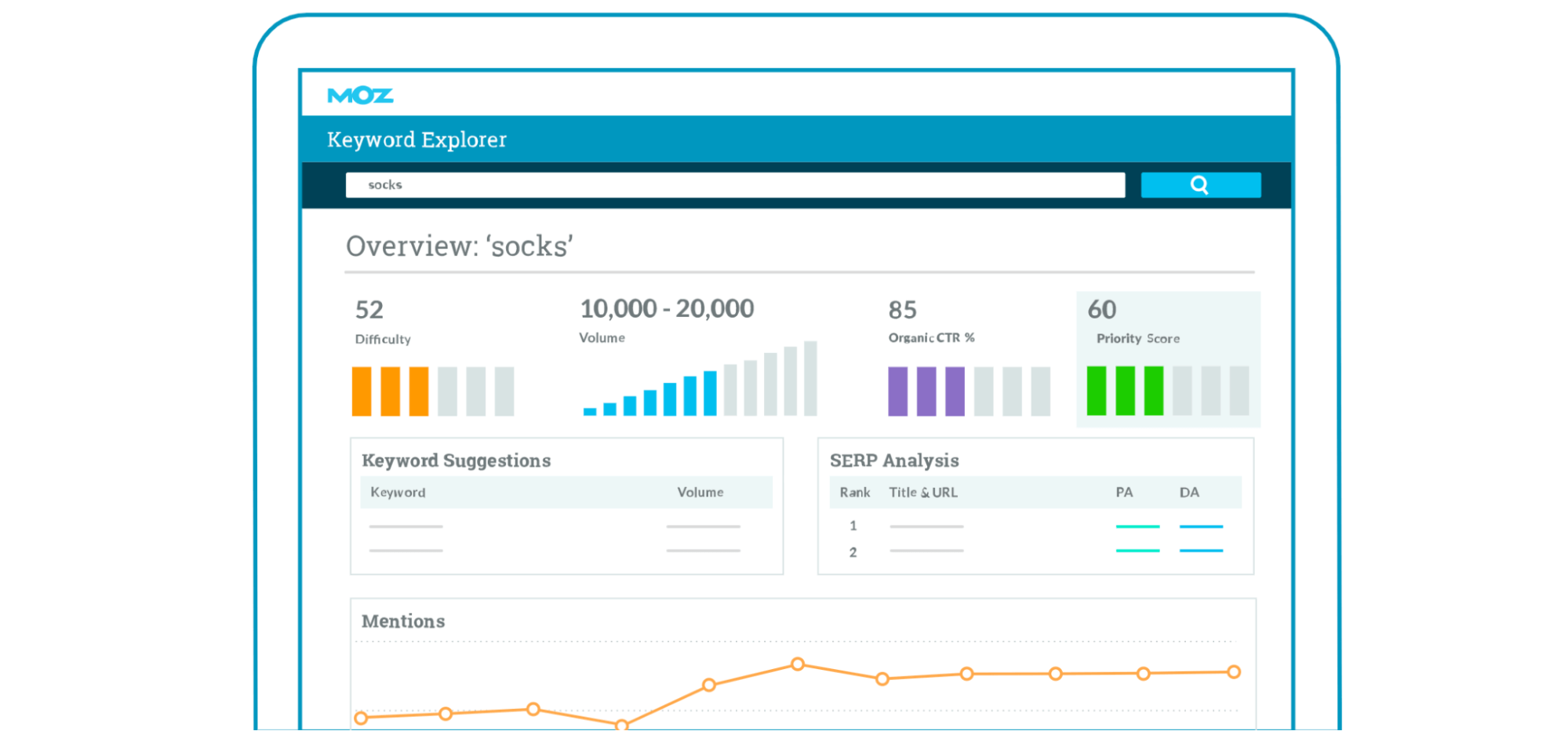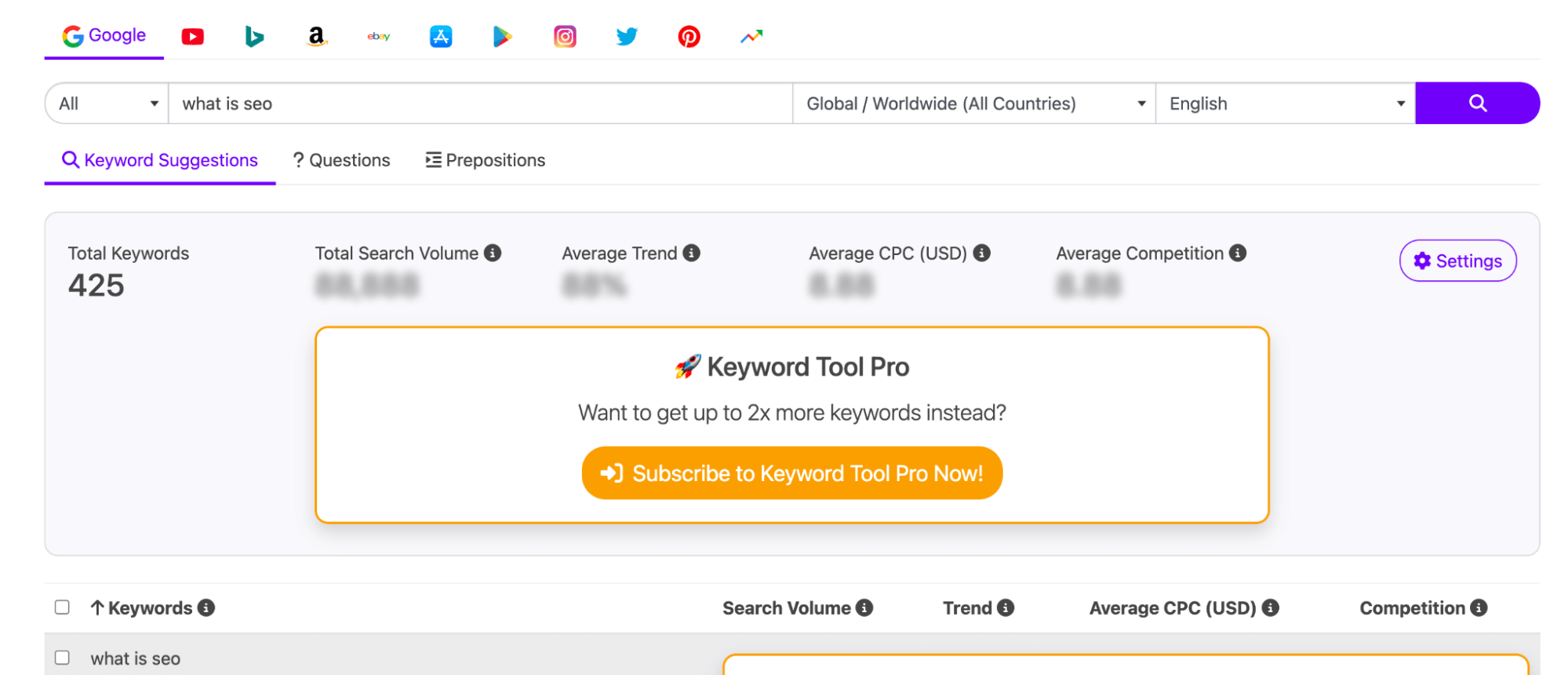Keyword search volume is a metric that tells you how many times a key phrase is searched for within a certain time period, usually a month. It can help you find popular and competitive keywords for your website, PPC campaign, or SEO strategy.
This metric helps digital marketers and content creators to understand which words are most likely to drive traffic to their websites. By optimizing content to include high-volume search terms, they can improve their chances of appearing in search engine results and attracting more visitors.
However, it’s also essential to consider the competition and difficulty associated with ranking for these words, as some may be highly competitive due to many websites trying to rank for them.
Several tools, like Google’s Keyword Planner, Ahrefs, SEMRush, etc., can provide estimates of word search volumes. It’s important to remember that these figures are estimates and may not be completely accurate. They should be used as a general guide for keyphrase selection and strategy.
Good search volume for a keyword depends on your goals, industry, and audience, but you generally want to find keyphrases with high volume and low difficulty.
Keywords Impact on SEO
They serve as a pivotal element in Search Engine Optimization (SEO), profoundly influencing a website’s visibility, audience engagement, and positioning on Search Engine Results Pages (SERPs). Here’s an elucidation on their impact:
- Content Indexing. Keywords aid search engines in deciphering the essence of your content. Proper optimization of your content with pertinent keyphrases enhances its indexability, thus enabling search engines to display your pages to users searching for related terms.
- Audience Attraction. Words with high volume can potentially channel considerable traffic to your site, granting your content ranks favorably for them. By cognizing the search habits of your target demographic and integrating those keyphrases into your content, you can captivate a larger audience.
- User Experience Enhancement. Effectively deployed keywords can augment user experience. If users land on your site and discover precisely the information they were seeking (owing to your content’s accurate reflection of the searched phrases), they are likely to delve deeper into your site and possibly convert (make a purchase, subscribe to a newsletter, etc.).
- Competitive Positioning. Keyphrases with high volume often face fierce competition, making it challenging to secure a high ranking. However, “long-tail” key phrases—more specific, lengthier phrases with lower search volumes—may face less competition. Balancing your optimization between high-volume and long-tail phrases can ensure optimal visibility amidst competitive scenarios.
- Content Strategy Formulation. Keywords can steer your content strategy. Conducting research on industry-relevant, product-specific, or service-specific key phrases allows you to discern the topics of interest to your audience and craft content that caters to their needs.
- Local SEO Optimization. For enterprises operating on a local scale, deploying geographically specific phrases can channel traffic from local searches, thereby bolstering local SEO efforts.
Bear in mind, while keyphrases carry weight, contemporary SEO strategies eschew keyword stuffing (excessive usage of keywords in content). Search engines like Google are increasingly prioritizing the overall pertinence and quality of content.

Choosing words should never be an exercise solely based on their search volume.
Keyword research goes way beyond merely targeting keyphrases with the highest search volume.
Additional factors that need careful consideration:
- Would this keyword significantly contribute to my business’s objectives?
- Could this keyword potentially lead to conversions or sales?
- Is it feasible to outperform the current top-ranking pages for this keyword?
- What resources or efforts would be necessary to rank for this keyword?
These questions should form the core of your decision-making process when determining the most suitable keyphrases for your needs.
Therefore, it employs words naturally and in a manner that genuinely elevates the value of your content.
How Do You Find Keywords
Ascertaining the right keywords for your business can significantly impact your digital presence, influencing your website’s traffic, engagement, and overall visibility on search engines. This process, however, requires a thoughtful blend of creativity, strategic investigation, and continuous analysis.
To guide you through this essential aspect of digital marketing, here are seven effective steps for identifying the optimal key phrases for your business:
| Brainstorming | Start by making a list of important, relevant topics based on what you know about your business and your industry. Think about the search terms your customers might use to find your products or services. |
| Google Suggestions | Use Google’s autocomplete feature to identify additional keyphrases. Start typing a word into the search box and see what additional terms Google suggests. These are phrases that people frequently search for. |
| Competitor Analysis | Look at which keyphrases your competitors are targeting. Tools like SEMRush and Ahrefs can help you find the words driving traffic to your competitors’ websites. While you don’t want to copy your competitors’ strategy, this can provide valuable insights. |
| Long-Tail Keywords | Don’t forget to look for long-tail keywords. These are longer, more specific phrases that often have lower competition. While they may have lower search volumes individually, collectively, they often make up a significant portion of search-driven traffic. |
| Analyze Keyword Relevance and Metrics | Finally, make sure the keyphrases you select are highly relevant to your content and have a good balance of search volume and competition. High-volume words might seem attractive, but they can often be more competitive. |
| Consider User Intent | Lastly, consider the user intent behind each keyword. Some keyphrase might have a high search volume, but if the people searching for that word aren’t interested in your product or service, it won’t drive the results you want. |
Remember, keyword research isn’t a one-and-done task. It should be an ongoing part of your SEO strategy, as search trends can change over time.
Regularly revisiting and updating your strategy can help you maintain a successful SEO campaign.
Tools That Help Discover Keyword Search Volume
It can be found using various online tools that offer keyword analytics. These tools provide a lot of data about keyphrases, including their search volume, competitiveness, and sometimes even the cost per click (CPC) in paid search advertising. Here are some commonly used tools:
SEMRush
This is a comprehensive SEO tool that offers several important features. SEMRush keyword research shows you the volume, ranking difficulty, and also provides a list of related keyphrases.

Ahrefs
Another robust SEO tool, Ahrefs, provides in-depth data, including search volume, ranking difficulty, and related keyphrases. It also offers an explorer feature that provides a detailed report, not to mention the Ahrefs’ keyword generator that can help come up with new ideas.

Moz’s Keyword Explorer
This tool offers both monthly search volume and scoring difficulty. It also provides suggestions for similar keyphrases.

Ubersuggest
Ubersuggest is a tool by Neil Patel that provides keyphrases ideas, search volume, difficulty, and more.

KWFinder
KWFinder specializes in finding long-tail phrases with low SEO difficulty, providing search volumes, trends, and other useful metrics.

Keyword Tool
This tool leverages Google Autocomplete data to generate a large number of relevant long-tail keyphrases for any topic and provides estimated search volumes.

Please note that while some of these tools offer limited free usage, most require a subscription for full access. Also, different tools might give slightly different results, as their algorithms and data sources vary.
It’s often beneficial to use more than one tool and cross-reference the data when conducting keyword research.
Keyword Sheeter
Keyword Sheeter is an online tool that generates a great load of suggestions based on your input. Although it doesn’t inherently provide search volumes, its strength lies in creating a comprehensive list of related keyphrases pulled from Google’s autocomplete feature.

For specific search volume data, you can export the list of generated keyphrases and analyze it further with tools like Google Keyword Planner, SEMRush, or Ahrefs. In essence, while Sheeter doesn’t directly provide search volume data, it serves as an excellent starting point for large-scale keyword idea generation.
Googles Tools for Free Discover Keywords
Google Search Console is a powerful tool that helps track and improve your website’s presence in Google search results. Its “Performance” section displays search queries leading users to your site, providing data on impressions, clicks, click-through rate, and average search ranking. This information can highlight well-performing words and those needing improvement.

Google Search Console can reveal unknown keyword opportunities by showing search queries your site appears for. Also, by analyzing existing key phrases’ performance, you can refine your content to enhance their ranking. Insights into user behavior, like a low click-through rate, can signal the need for improved meta descriptions or title tags.
Furthermore, the tool identifies your website’s high and low-performing pages, guiding your keyword optimization efforts. As the data is based on actual searches, it provides reliable insights for your research, enabling informed decisions to boost your website’s search visibility.
Google Keyword Planner
This free tool by Google is designed for advertisers, but is also widely used for SEO purposes. It provides search volume estimates for your chosen keyphrases and can also suggest additional relevant words.

Google Trends
Google Trends is a beneficial tool for keyword research, providing insights into the popularity of search queries across different regions and languages. It’s useful for identifying seasonal patterns, like increased searches for “Christmas decorations” in December, which can guide businesses with seasonal offerings.

Google Trends also aids in comparing similar words based on their search volume trends, helping you make more informed decisions. It suggests related queries and trending queries associated with your primary keyword, which can offer new ideas or timely content opportunities.
Regional interest data provided by Google Trends assists in tailoring strategies for targeted geographical areas. Plus, its ability to show long-term trends from as far back as 2004 helps understand the cyclic nature of certain key phrases. By leveraging Google Trends, you can enrich your research and strategize your SEO efforts effectively.
Common Mistakes and Their Solutions for Keywords Search Volumes
Keyword volume is a necessary factor in SEO and PPC campaigns. However, several common mistakes can hinder its effective use. Here they are, along with their solutions:
Focusing Only on High Volume Keywords
Many marketers target only high volume keywords, believing that they’ll drive the most traffic. However, these words often have high competition.
Ignoring Seasonal Variations
Some words can have significant fluctuations in search volumes throughout the year, leading to missed opportunities or wasted efforts.
Choosing Keywords Irrelevant to Your Audience
You might target a keyword with high search volume that isn’t relevant to your audience, leading to low engagement and conversion rates.
Neglecting Local SEO
If you’re a local business or have a physical location, focusing only on generic keywords could lead you to miss potential local customers.
Not Updating Keyword Research
Keyword popularity can change over time. If you’re using outdated data, your SEO and PPC efforts might be misdirected.
Not Considering Searcher Intent
Even if a word has a high volume, it may not lead to conversions if it doesn’t match the searcher’s intent.
By avoiding these common mistakes and implementing these solutions, you can utilize keyword search volume more effectively in your SEO and PPC campaigns.
Conclusion
Keyword search volume is paramount for effective SEO strategies, impacting a website’s visibility and audience engagement. Tools like Google’s Keyword Planner, Ahrefs, and SEMRush can provide estimates of these volumes.
Successful strategies balance high volume and low difficulty keywords, considering factors like user intent and seasonal variations. However, it’s important to avoid common pitfalls such as focusing solely on high volume words or neglecting local SEO.
Regular updates of your keyword strategy can help maintain success in the ever-changing landscape of SEO.




